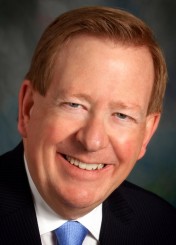
The Carmel City Council approved a nearly $131 million budget for 2017 on Oct. 17, which includes a tax decrease, but Carmel Mayor Jim Brainard said there’s no rate cap resolution for 2017, which means, “the budget sets the rate,” he said.
A rate cap resolution is a law passed by the City Council that says that the city rate for property taxes is set at a maximum amount and cannot exceed that. For many years, the council has passed a rate cap resolution, and as a result the tax rate is close to that cap.
For 2016, a proposal would have capped the city tax rate at 70.07 cents per $100, but that died when the city council voted it down in October 2015, 3-4. Instead, the 2016 rate ended up being 83.56 cents per $100 or 19 percent greater than the rate attached to the budget. The lack of a rate cap was one reason taxes went up, but it’s also due to the council appealing the state to recoup more than $4 million in miscalculated taxes during the annexation of West Clay. That accounts for about 6 cents per $100 of the 2016 city rate increase.
For 2017, that 6 cents per $100 will go away, leading to a tax decrease. The council voted 4-3 to pass a rate of 78.85 cents per $100 for 2017.
Brainard said he didn’t want a rate cap resolution for 2017 because it allows for more flexibility without it.
“The rate can float a little bit based on assessed value, but we also did the budget later in the year so we have a better idea of the variables,” he said.
When asked if that means taxes could increase, he said he doesn’t think that’s likely. First, he explained that the overall tax rate is comprised of many parts, some of which could fluctuate, but he thinks the city’s projections are sound.
“We expect to be close to our projections from our financial advisor,” he said. “It might be somewhat different based on appeals and other factors, but it’ll be close.”
During the Oct. 17 meeting, there was a discussion about how much of a tax reduction should be made for 2017. Brainard proposed a penny more than what was passed, saying it would ensure a sufficient operating balance at the end of the year. Despite the penny per $100 difference, Brainard said the city should be fine.
“We are covering the budget with sufficient operating revenue,” he said. “We usually end the year with about $30 million operating revenue.”
Brainard said ending operating balances are important not just because there might be an unexpected financial need, but also because bond rating agencies look at that when they rate the city’s debt, which affects interest rates.
“They want to see a reasonable operating balance,” he said. “If the ending balance is too high, then you’re hoarding money and you probably should be cutting taxes.”


